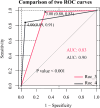Machine learning-driven simplification of the hypomania checklist-32 for adolescent: a feature selection approach
- PMID: 39692968
- PMCID: PMC11655905
- DOI: 10.1186/s40345-024-00365-4
Machine learning-driven simplification of the hypomania checklist-32 for adolescent: a feature selection approach
Abstract
Background: The Hypomania Checklist-32 is widely used to screen for bipolar disorder, but its length can be challenging for adolescents with manic symptoms. This study aimed to develop a shortened version of the HCL-32 tailored for adolescents using machine learning techniques.
Methods: Data from 2,850 adolescents (mean age 15.50 years, 68.81% female) who completed the HCL-32 were analyzed. Random forest (RF) and gradient boosting machine (GBM) algorithms were employed for feature selection. The area under the curve (AUC) was used to evaluate model performance. Receiver operating characteristic (ROC) analysis was conducted to determine optimal cutoff points for the shortened scale.
Results: An 8-item version of the HCL-32 was derived, maintaining high predictive accuracy (AUC = 0.97). The selected items captured core symptoms of adolescent mania, including increased energy, risk-taking, and irritability. Two cutoff points were identified: a score of 3 offered high specificity (0.98) and positive predictive value (0.98), while a score of 4 provided balanced sensitivity (0.87) and specificity (0.94) with the highest overall accuracy (0.91).
Conclusions: The machine learning-driven 8-item version of the HCL-32 demonstrates strong diagnostic utility for adolescent bipolar disorder, offering a more efficient screening tool without sacrificing clinical sensitivity. This shortened scale may improve assessment feasibility and accuracy in clinical settings, addressing the unique challenges of diagnosing bipolar disorder in adolescents.
Keywords: Feature selection; Gradient boosting machine; Manic symptoms; Random forest; Scale reduction.
© 2024. The Author(s).
Conflict of interest statement
Declarations. Ethics approval and consent to participate: The authors assert that all procedures contributing to this work comply with the ethical standards of the relevant national and institutional committees on human experimentation and with the Helsinki Declaration of 1975, as revised in 2008. All procedures involving human subjects/patients were approved by IRB in Wenzhou Seventh People’s Hospital (No. 202402). Competing interests: The authors declare no competing interests.
Figures




References
-
- Angst J, Adolfsson R, Benazzi F, Gamma A, Hantouche E, Meyer TD, et al. The HCL-32: towards a self-assessment tool for hypomanic symptoms in outpatients. J Affect Disord. 2005;88(2):217–33. - PubMed
-
- Brotman MA, Kircanski K, Leibenluft E. Irritability in children and adolescents. Annu Rev Clin Psychol. 2017;13(1):317–41. - PubMed
-
- Bystritsky A, Nierenberg AA, Feusner JD, Rabinovich M. Computational non-linear dynamical psychiatry: a new methodological paradigm for diagnosis and course of illness. J Psychiatr Res. 2012;46(4):428–35. - PubMed
Grants and funding
LinkOut - more resources
Full Text Sources

